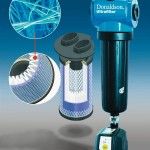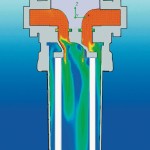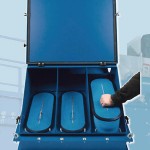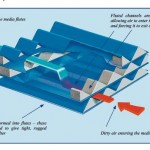Energy is becoming more expensive. Medium-sized companies especially are experiencing rising cost pressures. Although reducing operating costs is not a cure-all, there are many “thumbscrews” that plant managers can use. One good example is the filtration technology employed for process air treatment and dust collection.
Stefaan Kennis, Ludger Mintert
Along with electricity, water and gas, compressed air is one of the most commonly used energy sources in industry. The filtration technology plays a critical role in the treatment of compressed air, which in the chemical sector frequently serves as process air. This is also the area in which the most significant energy saving potentials exist, because a large number of compressed air filters are installed downstream of compressors, upstream and downstream of compressed air dryers and locally at the points of consumption. Donaldson’s new compressed air filters have been on the market for over a year now. Their use can lead to a substantial reduction in energy costs, enabling a return on investment of less than 12 months. The launch of this filter generation has resulted in a fundamental change in the factors for evaluating the commercial feasibility of compressed air and gas filtration. Each of these industrial filters enables the energy costs per annum to be cut by several hundred, if not thousand, euros. Furthermore, installation and servicing have been considerably simplified by the specially designed filter housing and are thus more efficient. The advantages of the energy saving filter have been confirmed by an objective analysis of its performance data according to ISO 12500-1. This ISO standard governs the measurement of compressed air filter performance based on defined criteria, making the data more transparent and comparable.
Looking for “thumbscrews”
Today, users of compressed air expect a filter to guarantee a high retention rate and reliably hold back even the smallest particles. However, how can the desired level of compressed air quality, as laid down by the quality classes in ISO 8573-1, be achieved most economically? The indirect energy consumption that is generated by the differential pressure is the crucial factor here. With a 7 bar system, expenditure on energy rises 10 % for every 1 bar increase in differential pressure. Assuming an installed compressor performance of 100 kW, a workload of 8000 operating hours per year and an energy price of 0.08 euros/kWh, the additional costs add up to 6400 euros. In their search for potential ways to reduce the differential pressure, Donaldson’s engineers turned to their worldwide laboratories, in which the necessary tests on new components can be carried out under real conditions. Several “thumbscrews” for optimising the differential pressure were identified.
Optimised air flow
One important objective for the developers of the new industrial filter was to optimise the air flow. Computer aided simulation provided the starting point for the turbulence-free design with a streamlined flow of air through the filter housing and into the element. This design ensures very small pressure losses. It also features a filter that repels water and oil at an early stage, thus keeping a large surface available for the retention of particles and the separation of liquid aerosols. Users benefit from the longer service life of the elements and the permanently low differential pressure. The arrangement of the filter in the support sheath was also redesigned in addition to modifying the housing and the element. The pleating process employed here entails optimising the pleat height and the number of pleats. This guarantees the maximum possible flow surface and reduces pressure loss to a minimum. The filter itself is manufactured from ultra-fine borosilicate fibres of a consistently high quality, which contribute significantly to the low differential pressure over the entire service life. The quantitative results of the development work are convincing: the pressure loss has been approximately halved. Other filters available in the market have a pressure loss of 450 to 500 mbar in the wetted state, while the figure for the new Donaldson industrial filter series is only 250 mbar. The saving for users is enormous. Assuming a flow rate of 1100 m³/h, annual energy costs can be cut by as much as 1500 euros when the differential pressure is just 200 mbar lower. This is several times the purchase price of the filter. The investment thus pays for itself within a few months even if an existing filter housing is replaced.
Calculable costs
Integrating the economiser into the filter head not only lowers the total costs for the user, it also makes them easier to be calculated. The economiser regularly measures the differential pressure produced, compares the associated high energy costs with the price of a new filter and calculates the most economical point in time for a filter change with the help of an internal processor. An LED indicates when the filter is due for replacement and optionally sends a signal to a central master display via a universal 4…20 mA interface. Donaldson’s new industrial filters are extremely versatile. With nine different sizes, this latest generation of compressed air filters covers the complete performance spectrum, namely with flow rates from 35 to 1100 m³/h and actual compressor outputs from 2 to 120 kW. Various filter media are available depending upon the intended application, from dust filtration through pre-separation to fine, micro and sub-micro filtration.
Dust collection technology
The development potential latent in the filtration system is also demonstrated by the Powercore dust collection technology, which is designed for a wide range of applications in chemical production. Donaldson’s Torit DCE units featuring the new Powercore technology are up to 70 % smaller than their conventional counterparts. The significance of this development is clearly illustrated by the following example: only 12 Powercore filter packs are required for a dust collection unit that previously had to be equipped with 81 bag filters, each 2.40 m in length. Two essential factors lie behind this performance increase. As a manufacturer of intake filters for compressors and heavy-duty vehicles, Donaldson was able to draw on its experience in these areas and apply it to the dust collection technology. The Powercore filter packs unite the latest findings of filter media manufacturing with the patented Ultra-Web nanofibre technology. The filter medium – similarly shaped to that of an intake filter – is formed into fluted channels and layered in such a way that a tight, rugged structure is created. The rounded profile of the Powercore filter packs in conjunction with the patented Ultra-Web filter media allows a higher dust load to be collected on the surface of the flutes than would be possible with conventional fibre filters with a depth loading of 540 g/m2 of standard polyester. This high surface filtration efficiency combined with the patented pulse cleaning technology represents the key to the long service life. This and the optimal flow direction facilitate an impressive performance increase, even when space is severely restricted, with a minimal pressure drop and energy input.
Nanofibre technology
The high filtration performance is enabled by the Ultra-Web nanofibre technology. The filter medium consists of nanofibres that are made in an electrospinning process. This technique delivers a very fine, continuous fibre with a diameter of only 0.2 to 0.3 µm. A resistant, web-like net with minute interfibre spaces, much smaller than those of conventional filter media, is formed from this fibre. This has the advantage that particles in the sub-micron and micron range are retained on the filter surface rather than deep down inside the filter medium. The benefits for cleaning efficiency when linked to the Powercore filter pack are immense. Powercore was developed in response to the demands for user and maintenance-friendly dust collectors that were voiced in many branches of industry for years – not only because of the extreme downsizing but also due to the ease of filter replacements.
Donaldson Filtration susanne.fulko@emea.donaldson.com www.donaldson.com
Share:










